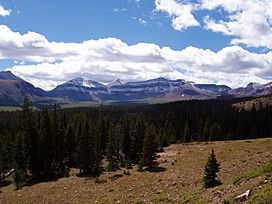Wasatch and Uinta montane forests facts for kids
Quick facts for kids Wasatch and Uinta montane forests |
|
|---|---|

Coniferous forest with Kings Peak in the background, Uinta Mountains
|
|
 |
|
| Ecology | |
| Realm | Nearctic |
| Biome | Temperate coniferous forest |
| Borders | Colorado Plateau shrublands, Wyoming Basin shrub steppe and Great Basin shrub steppe |
| Bird species | 190 |
| Mammal species | 91 |
| Geography | |
| Area | 41,500 km2 (16,000 sq mi) |
| Country | United States |
| States | Utah, Wyoming and Idaho |
| Conservation | |
| Habitat loss | 2.45% |
| Protected | 68.9% |
The Wasatch and Uinta montane forest is a special type of temperate coniferous forest found in the Wasatch Range and Uinta Mountains. These mountain ranges are part of the larger Rocky Mountains system in the western United States. This area is called an ecoregion because it has its own unique plants and animals.
Contents
Where Are These Forests Found?
This amazing forest ecoregion is mostly in the state of Utah. A small part of it also reaches north into southwestern Wyoming and southeastern Idaho. This area is quite dry compared to other parts of the Rocky Mountains. This is because it sits in the "rain shadow" of the Sierra Nevada mountains to the west. A rain shadow means the mountains block most of the rain, making the land on the other side much drier.
Plants of the Wasatch and Uinta Forests
The main type of plant life here is coniferous forest. Coniferous trees are those that have needles and cones, like pine trees. The most common trees you'll see include:
- Ponderosa pine (Pinus ponderosa)
- Rocky Mountain Douglas-fir (Pseudotsuga menziesii subsp. glauca)
- Subalpine fir (Abies lasiocarpa)
- Engelmann spruce (Picea engelmanni)
- Trembling aspen (Populus tremuloides), which are known for their leaves that "tremble" in the wind.
You might also find some limber pine (Pinus flexilis). What makes this ecoregion special is that large areas are covered by Gambel oak (Quercus gambelii). These oak trees are not as common in other Rocky Mountain forests.
Animals Living in the Forests
Many different mammals call these forests home. Some of the animals you might spot include:
- Mule deer (Odocoileus hemonius)
- Elk (Cervus canadensis)
- Moose (Alces alces)
- Bighorn sheep (Ovis canadensis)
- Mountain goat (Oreamnos americanus)
- Black bear (Ursus americanus)
- Cougar (Puma concolor), also known as a mountain lion.
Protecting These Special Forests
Unfortunately, many parts of this ecoregion have been changed by human activities. Things like livestock grazing (where animals eat the plants), logging (cutting down trees), mining, and fun activities like downhill skiing have all had an impact. Because of these changes, these forests need a lot of protection.
Not many areas are officially protected. The largest protected area is the High Uintas Wilderness in northeastern Utah. However, this wilderness area mainly protects the very high mountain parts, called the alpine zone. The lower mountain areas, known as the montane and subalpine zones, are home to more different types of plants and animals, but they are mostly unprotected.
The biggest challenges to keeping these forests healthy are:
- Motorized recreation, like off-road vehicles.
- Widespread livestock grazing.
- Downhill skiing development.
In recent years, these forests have also been badly affected by outbreaks of the mountain pine beetle. These tiny beetles can kill many trees, causing large sections of the forest to die. Efforts are being made to manage these threats and help the forests recover.

